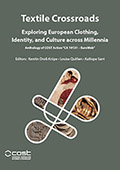Center, Textile Research

Textile Crossroads: Exploring European Clothing, Identity, and Culture across Millennia
Date of this Version
2024
Document Type
Article
Citation
In Textile Crossroads: Exploring European Clothing, Identity, and Culture across Millennia. Anthology of COST Action “CA 19131 – EuroWeb”. Kerstin Droß-Krüpe, Louise Quillien, & Kalliope Sarri, Editors. Zea Books, Lincoln, Nebraska, 2024. DOI: 10.32873/unl.dc.zea.1813
Abstract
Textiles, with their economic, sartorial, and identity-constructing functions, have long been at the center of cultural discourses, whether narrative or visual. Objects of desire, but also objects of curiosity, textiles have been the topic of costume books, offered in diplomatic exchanges, collected by private collectors and museums alike, and have traveled, sometimes as sample books. Their Othering function did not only differentiate between members of different civilizations, but also the members of the same society, where clothing was used to signal rank and function. The case studies presented intend to elaborate further on the role and symbolism associated with textiles, by reiterating their centrality in their various forms, whether costume albums (Cabrera Lafuente), collected textile pieces (Coman), costumes created for the burgeoning film industry (Kulpa), or as samples for a society wardrobe (Parry-Williams). The common characteristics of the specific examples build on the use of textiles to signal Othering, exotic curiosity, and even sexually charged sensuality, or Orientalist interest in the Asia Minor populations. In many of the examples analyzed, the impact of Western and Western-influenced discourses is discernible, to the point of the self-fashioning of a collector originating from interwar Romania (a former Danubian Principalities tributary to the Ottoman Empire) who commissioned a portrait of himself wearing the clothing of what he calls an “Arab sheikh.” During the 18th and 19th centuries, the Western world embraced a broadly racialized perspective, Othering non-white peoples in the colonial context. Orientalism served as an intellectual justification for imperialism, portraying the Eastern world as ‘primitive’, and in need of modernization through the civilizing mission. Colonial empires thrived on essentialist representations, establishing a binary division between The Orient and The Occident, perpetuating the Western Self and the non-western Other. Orientalism played a role in cultural imperialism by promoting homogenization, feminization, and essentialization, reinforcing the perceived superiority of Western civilization. Even though we have been living in a postcolonial world for decades, the study of Exoticism, Othering, and Orientalism remains relevant, and demands scholarly inquiry. This brings forth the need for a specific methodology inherent to each case study and, at the same time, unites them in the nuanced approach to the main applied concepts.
Included in
Ancient History, Greek and Roman through Late Antiquity Commons, Archaeological Anthropology Commons, Classical Archaeology and Art History Commons, Classical Literature and Philology Commons, Eastern European Studies Commons, European History Commons, European Languages and Societies Commons, Fiber, Textile, and Weaving Arts Commons, History of Science, Technology, and Medicine Commons, Human Geography Commons, Museum Studies Commons, Place and Environment Commons, Social and Cultural Anthropology Commons, Women's Studies Commons


Comments
Copyright © 2024 by the authors.